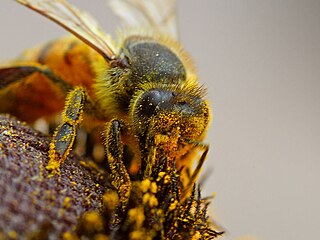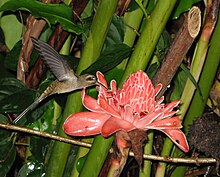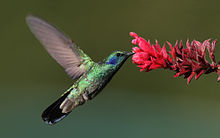
Hummingbirds are birds native to the Americas and comprise the biological family Trochilidae. With approximately 366 species and 113 genera, they occur from Alaska to Tierra del Fuego, but most species are found in Central and South America. As of 2024, 21 hummingbird species are listed as endangered or critically endangered, with numerous species declining in population.

A pollinator is an animal that moves pollen from the male anther of a flower to the female stigma of a flower. This helps to bring about fertilization of the ovules in the flower by the male gametes from the pollen grains.

Hoverflies, also called flower flies or syrphids, make up the insect family Syrphidae. As their common name suggests, they are often seen hovering or nectaring at flowers; the adults of many species feed mainly on nectar and pollen, while the larvae (maggots) eat a wide range of foods. In some species, the larvae are saprotrophs, eating decaying plant and animal matter in the soil or in ponds and streams. In other species, the larvae are insectivores and prey on aphids, thrips, and other plant-sucking insects.

In biology, coevolution occurs when two or more species reciprocally affect each other's evolution through the process of natural selection. The term sometimes is used for two traits in the same species affecting each other's evolution, as well as gene-culture coevolution.

Pollination is the transfer of pollen from an anther of a plant to the stigma of a plant, later enabling fertilisation and the production of seeds, most often by an animal or by wind. Pollinating agents can be animals such as insects, for example beetles or butterflies; birds, and bats; water; wind; and even plants themselves. Pollinating animals travel from plant to plant carrying pollen on their bodies in a vital interaction that allows the transfer of genetic material critical to the reproductive system of most flowering plants. When self-pollination occurs within a closed flower. Pollination often occurs within a species. When pollination occurs between species, it can produce hybrid offspring in nature and in plant breeding work.

Sunbirds and spiderhunters make up the family Nectariniidae of passerine birds. They are small, slender passerines from the Old World, usually with downward-curved bills. Many are brightly coloured, often with iridescent feathers, particularly in the males. Many species also have especially long tail feathers. Their range extends through most of Africa to the Middle East, South Asia, South-east Asia and southern China, to Indonesia, New Guinea and northern Australia. Species diversity is highest in equatorial regions.

Heliconia is a genus of flowering plants in the monotypic family Heliconiaceae. Most of the 194 known species are native to the tropical Americas, but a few are indigenous to certain islands of the western Pacific and Maluku in Indonesia. Many species of Heliconia are found in the tropical forests of these regions. Most species are listed as either vulnerable or data deficient by the IUCN Red List of threatened species. Several species are widely cultivated as ornamentals, and a few are naturalized in Florida, Gambia, and Thailand.
Parallel evolution is the similar development of a trait in distinct species that are not closely related, but share a similar original trait in response to similar evolutionary pressure.

Babiana ringens, the rat's tail, is a flowering plant endemic to Cape Province of South Africa. The foliage is long and erect with an inflorescence consisting of a sterile main stalk adapted for ornithophily, pollination by birds. The plant bears bright red, tubular flowers on side branches close to the ground. It is a perennial that grows in nutrient-poor sandy soil and flowers during the winter rains.

Entomophily or insect pollination is a form of pollination whereby pollen of plants, especially but not only of flowering plants, is distributed by insects. Flowers pollinated by insects typically advertise themselves with bright colours, sometimes with conspicuous patterns leading to rewards of pollen and nectar; they may also have an attractive scent which in some cases mimics insect pheromones. Insect pollinators such as bees have adaptations for their role, such as lapping or sucking mouthparts to take in nectar, and in some species also pollen baskets on their hind legs. This required the coevolution of insects and flowering plants in the development of pollination behaviour by the insects and pollination mechanisms by the flowers, benefiting both groups. Both the size and the density of a population are known to affect pollination and subsequent reproductive performance.

Zoophily, or zoogamy, is a form of pollination whereby pollen is transferred by animals, usually by invertebrates but in some cases vertebrates, particularly birds and bats, but also by other animals. Zoophilous species frequently have evolved mechanisms to make themselves more appealing to the particular type of pollinator, e.g. brightly colored or scented flowers, nectar, and appealing shapes and patterns. These plant-animal relationships are often mutually beneficial because of the food source provided in exchange for pollination.

Nectar is a sugar-rich liquid produced by plants in glands called nectaries or nectarines, either within the flowers with which it attracts pollinating animals, or by extrafloral nectaries, which provide a nutrient source to animal mutualists, which in turn provide herbivore protection. Common nectar-consuming pollinators include mosquitoes, hoverflies, wasps, bees, butterflies and moths, hummingbirds, honeyeaters and bats. Nectar plays a crucial role in the foraging economics and evolution of nectar-eating species; for example, nectar foraging behavior is largely responsible for the divergent evolution of the African honey bee, A. m. scutellata and the western honey bee.

In zoology, a nectarivore is an animal which derives its energy and nutrient requirements from a diet consisting mainly or exclusively of the sugar-rich nectar produced by flowering plants.

In zoology, a palynivore /pəˈlɪnəvɔːɹ/, meaning "pollen eater" is an herbivorous animal which selectively eats the nutrient-rich pollen produced by angiosperms and gymnosperms. Most true palynivores are insects or mites. The category in its strictest application includes most bees, and a few kinds of wasps, as pollen is often the only solid food consumed by all life stages in these insects. However, the category can be extended to include more diverse species. For example, palynivorous mites and thrips typically feed on the liquid content of the pollen grains without actually consuming the exine, or the solid portion of the grain. Additionally, the list is expanded greatly if one takes into consideration species where either the larval or adult stage feeds on pollen, but not both. There are other wasps which are in this category, as well as many beetles, flies, butterflies, and moths. One such example of a bee species that only consumes pollen in its larval stage is the Apis mellifera carnica. There is a vast array of insects that will feed opportunistically on pollen, as will various birds, orb-weaving spiders and other nectarivores.

Pollination syndromes are suites of flower traits that have evolved in response to natural selection imposed by different pollen vectors, which can be abiotic or biotic, such as birds, bees, flies, and so forth through a process called pollinator-mediated selection. These traits include flower shape, size, colour, odour, reward type and amount, nectar composition, timing of flowering, etc. For example, tubular red flowers with copious nectar often attract birds; foul smelling flowers attract carrion flies or beetles, etc.

The malachite sunbird is a small nectarivorous bird found from the highlands of Ethiopia southwards to South Africa. They pollinate many flowering plants, particularly those with long corolla tubes, in the Fynbos.

Nectar robbing is a foraging behavior used by some organisms that feed on floral nectar, carried out by feeding from holes bitten in flowers, rather than by entering through the flowers' natural openings. Nectar robbers usually feed in this way, avoiding contact with the floral reproductive structures, and therefore do not facilitate plant reproduction via pollination. Because many species that act as pollinators also act as nectar robbers, nectar robbing is considered to be a form of exploitation of plant-pollinator mutualism. While there is variation in the dependency on nectar for robber species, most species rob facultatively.

In ethology and behavioral ecology, trap-lining or traplining is a feeding strategy in which an individual visits food sources on a regular, repeatable sequence, much as trappers check their lines of traps. Traplining is usually seen in species foraging for floral resources. This involves a specified route in which the individual traverses in the same order repeatedly to check specific plants for flowers that hold nectar, even over long distances. Trap-lining has been described in several taxa, including bees, butterflies, tamarins, bats, rats, and hummingbirds and tropical fruit-eating mammals such as opossums, capuchins and kinkajous. Traplining is used to term the method in which bumblebees and hummingbirds go about collecting nectar, and consequently, pollinating each plant they visit. The term "traplining" was originally coined by Daniel Janzen, although the concept was discussed by Charles Darwin and Nikolaas Tinbergen.

Flower constancy or pollinator constancy is the tendency of individual pollinators to exclusively visit certain flower species or morphs within a species, bypassing other available flower species that could potentially contain more nectar. This type of foraging behavior puts selective pressures on floral traits in a process called pollinator-mediated selection. Flower constancy is different from other types of insect specialization such as innate preferences for certain colors or flower types, or the tendency of pollinators to visit the most rewarding and abundant flowers.

Pollinator-mediated selection is an evolutionary process occurring in flowering plants, in which the foraging behavior of pollinators differentially selects for certain floral traits. Flowering plant are a diverse group of plants that produce seeds. Their seeds differ from those of gymnosperms in that they are enclosed within a fruit. These plants display a wide range of diversity when it comes to the phenotypic characteristics of their flowers, which attracts a variety of pollinators that participate in biotic interactions with the plant. Since many plants rely on pollen vectors, their interactions with them influence floral traits and also favor efficiency since many vectors are searching for floral rewards like pollen and nectar. Examples of pollinator-mediated selected traits could be those involving the size, shape, color and odor of flowers, corolla tube length and width, size of inflorescence, floral rewards and amount, nectar guides, and phenology. Since these types of traits are likely to be involved in attracting pollinators, they may very well be the result of selection by the pollinators themselves.





















